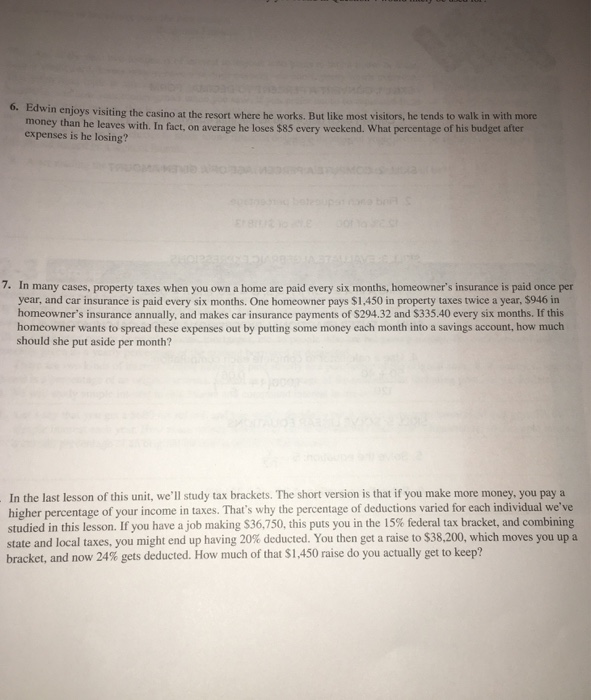6. Ed win enjoys visiting the casino at the resort where he works. But like most visitors, he tends to walk in with more money than he leaves with. In fact, on average he loses $85 every weekend. What percentage of his budget after expenses is he losing? 7. In many cases, property taxes when you own a home are paid every six months, homeowner's insurance is paid once per year, and car insurance is paid every six months. One homeowner pays $1.450 in property taxes twice a year, $946 in homeowner's insurance annually, and makes car insurance payments of $294.32 and $335.40 every six months. If this homeowner wants to spread these expenses out by putting some money each month into a savings account, how much should she put aside per month? In the last lesson of this unit, we'l study tax brackets. The short version is that if you make more money, you pay a higher percentage of your income in taxes. That's why the percentage of deductions varied for each individual we've s S36750. this puts you in the 15% federal tax bracket, and combing studied in this lesson. If you have a job making state and local taxes you might end up having 20% deducted. You then get a raise to $38,200, which moves you up a bracket, and now 24% gets deducted. How much of that $1,450 raise do you actually get to keep? 6. Ed win enjoys visiting the casino at the resort where he works. But like most visitors, he tends to walk in with more money than he leaves with. In fact, on average he loses $85 every weekend. What percentage of his budget after expenses is he losing? 7. In many cases, property taxes when you own a home are paid every six months, homeowner's insurance is paid once per year, and car insurance is paid every six months. One homeowner pays $1.450 in property taxes twice a year, $946 in homeowner's insurance annually, and makes car insurance payments of $294.32 and $335.40 every six months. If this homeowner wants to spread these expenses out by putting some money each month into a savings account, how much should she put aside per month? In the last lesson of this unit, we'l study tax brackets. The short version is that if you make more money, you pay a higher percentage of your income in taxes. That's why the percentage of deductions varied for each individual we've s S36750. this puts you in the 15% federal tax bracket, and combing studied in this lesson. If you have a job making state and local taxes you might end up having 20% deducted. You then get a raise to $38,200, which moves you up a bracket, and now 24% gets deducted. How much of that $1,450 raise do you actually get to keep







